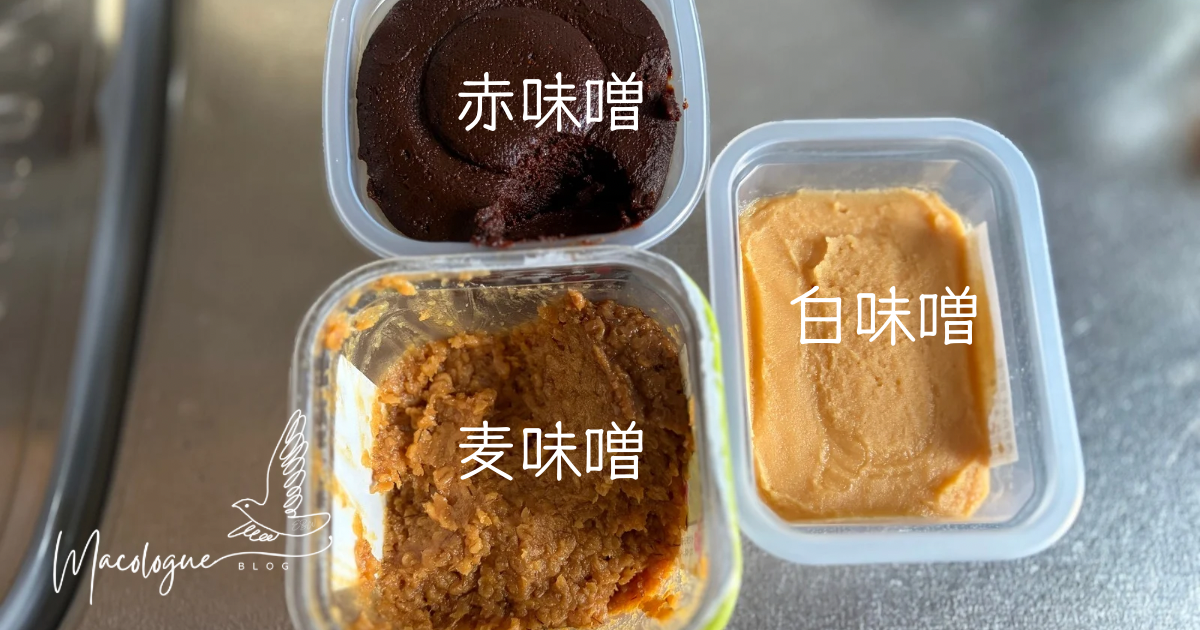
日本の食卓に欠かせない「味噌」。
実はひと口に味噌といっても、白味噌・赤味噌・麦味噌・合わせ味噌など、地域や作り方によって味も香りもまったく違います。
普段どのように味噌を選んでますか?
味噌は、発酵の力で生まれるスーパーフード。大豆のたんぱく質と麹菌の働きで、旨味やビタミン、乳酸菌が豊富に含まれています。毎日少しでも取り入れることで、腸内環境を整えたり、免疫力をサポートしたりと、体にうれしい効果がたくさん。
味噌の種類と特徴・おすすめ料理
風味や栄養の個性を知って、自分に合う味噌を選ぼう。
| 種類 | 色・味の特徴 | おすすめ料理 | 栄養・風味のポイント |
|---|---|---|---|
|
白味噌(西京)
|
淡いクリーム色で甘くまろやか。塩味控えめ。上品でやさしい味わい。 | ビタミンB1・B2が豊富。塩分は控えめ。短期熟成のため酵母が香り高く、朝食や体調の良くない時にも◎。 | |
|
麦味噌
|
麦麹由来の香ばしい甘み。九州・四国で親しまれる優しい味。 | 植物性乳酸菌が多く腸内環境を整える。甘みと香りのバランスが良く、胃腸にやさしい。 | |
|
赤味噌(豆味噌・八丁味噌)
|
濃い赤褐色でコクと旨みが強い。塩味しっかりで香ばしい風味。 | 長期熟成による抗酸化成分(メラノイジン)を多く含む。疲労回復・老化防止に◎。 | |
|
仙台味噌
|
やや濃い赤茶で香りが立つ。塩味がしっかりしてキレのある味。 | 発酵力が強い。酵母やアミノ酸が豊富。香りの成分が多く、寒い季節に体を温める。 | |
|
合わせ味噌
|
白味噌と赤味噌をブレンド。甘みとコクのバランスが良く、万能タイプ。 | 複数の味噌の栄養をミックス。ビタミン・アミノ酸のバランスが良く、日常使いに最適。 |
小さい頃、ワタシの家の近所に味噌屋さんがあって、サムネイルの画像のように味噌が樽に入っていて味噌をグラム単位で買っていました。 我が家は昔から麦味噌。

味噌汁の味噌量と水(だし)の分量〔都度ブレンド用〕
人数に合わせた目安。味噌の種類や具材の量で調整してOK。
| 人数 | 水(だし)の目安 | 味噌の目安量 | 小さじ換算 | コメント |
|---|---|---|---|---|
| 1人分 | 約200ml(お椀1杯) | 大さじ0.7〜0.8(約13〜15g) | 小さじ2〜2½ | 朝食や軽めの汁に。出汁をしっかりめに取ると上品。 |
| 2人分 | 約400ml | 大さじ1.3〜1.6(約25〜30g) | 小さじ4〜5 | 具材が多い時は味噌を少し多めに。 |
| 3人分 | 約600ml | 大さじ2〜2.5(約40〜45g) | 小さじ6〜7½ | 基準量。一般的な味噌汁の味わい。 |
| 4人分 | 約800ml | 大さじ2.7〜3.3(約55〜65g) | 小さじ8〜10 | 大鍋でまとめて作る時に。 |
※出汁は昆布+かつお、または顆粒だし小さじ½/200mlでもOK。味噌は火を止めてから溶くと風味が活きます。
一覧を見ていると他の味噌も食べてみたいなと思うけど突然種類を変えるのに抵抗があるので、いつもの味噌に他の味噌を加えてみる。。こんな方法を提案します。
ブレンド別 × 人数別 味噌量早見表(都度ブレンドの目安)
味噌汁1人分=水200mlを基準にしたブレンド比率と分量の目安です。
| ブレンドタイプ | 味噌の割合 | 1人分(小さじ換算) | 2人分 | 3人分 | 4人分 |
|---|---|---|---|---|---|
| 甘口タイプ 白7:合わせ3 |
白味噌多め。やさしい風味で朝の味噌汁に。 | 白1.8+合わせ0.7(計2.5) | 白3.5+合わせ1.5(計5.0) | 白5.0+合わせ2.0(計7.0) | 白7.0+合わせ3.0(計10) |
| コク深タイプ 赤7:合わせ3 |
赤味噌多め。豚汁や根菜に合う濃厚仕立て。 | 赤1.8+合わせ0.7(計2.5) | 赤3.5+合わせ1.5(計5.0) | 赤5.0+合わせ2.0(計7.0) | 赤7.0+合わせ3.0(計10) |
| 香ばしタイプ 麦5:赤5 |
香ばしさとコクのバランス。焼きおにぎり味噌にも。 | 麦1.3+赤1.3(計2.6) | 麦2.5+赤2.5(計5.0) | 麦3.8+赤3.8(計7.6) | 麦5.0+赤5.0(計10) |
| 万能タイプ 白5:赤5 |
毎日のお味噌汁に。具材を選ばないバランス型。 | 白1.3+赤1.3(計2.6) | 白2.5+赤2.5(計5.0) | 白3.8+赤3.8(計7.6) | 白5.0+赤5.0(計10) |
※味噌量はおおよその目安。出汁の濃さ・具材の水分で調整してください。味噌は火を止めてから溶くのがコツ。
細かすぎてわかりにくかった方へ、もっと簡単にまとめてみる。
白味噌を加えると、まろやか寄り
赤味噌を足すと、コクと香りが増す
麦味噌を混ぜると、香ばしさアップ
仙台味噌を加えると締まりのある味になる
味噌はお料理だけでなく、スイーツにも使えますよ。
味噌を使ったスイーツレシピを追加でアップします。
Translation
of the Japanes Tabl
A friendly guide to choosing, blending, and loving miso—plus easy soup ratios you can use every day.
When it comes to Japanese cooking, miso is essential. But “miso” isn’t just one thing—there are white misos, red misos, barley misos, blended misos—each with its own flavor, color, and aroma depending on the region and how it’s made.
Miso is a true superfood born from fermentation. Made from soybeans and koji, it’s naturally rich in umami, vitamins, and lactic acid bacteria. Even a little each day can help support your gut and immune system.
Types of Miso, Flavors & Best Pairings
Get to know each personality, then pick the one that suits your taste and routine.
| Type | Flavor & Color | Best For | Nutrition & Notes |
|---|---|---|---|
| White Miso (Saikyo) Mild, short-aged |
Pale cream, sweet and mellow, lighter saltiness, refined. | Saikyo-style grilled fish/chicken, Kyoto-style miso soup (turnip, tofu), vinegared miso dressings, dengaku. | Rich in B vitamins, generally lower salt. Short fermentation gives a fragrant aroma—great for breakfast or gentle days. |
| Barley Miso (Mugi) | Toasty sweetness from barley koji; loved in Kyushu & Shikoku. | Hiyajiru (cold miso soup), eggplant or taro miso soup, grilled miso rice balls. | Plenty of plant-based probiotics; balanced sweetness and aroma; easy on the stomach. |
| Red Miso (Bean / Hatcho) | Deep reddish-brown, bold umami and saltiness, roasted depth. | Miso nikomi udon, doteni, miso katsu, beef tendon stew. | Long aging creates antioxidants (melanoidins) that help with fatigue and healthy aging. |
| Sendai Miso | Aromatic, medium-strong, clean finish. | Grilled miso rice balls, miso oden, salmon chan-chan yaki. | Strong fermentation; rich in yeast and amino acids. The aroma warms you—perfect for cold days. |
| Blended Miso (Awase) | Mix of white & red—balanced sweetness and depth. | Tonjiru, everyday miso soup, miso-marinated fish or meat. | Combines nutrients and flavors from multiple miso types—great daily all-rounder. |
A little memory—and why I blend
When I was little, there was a miso shop near our house. Just like in the thumbnail image—big wooden barrels lined up—and we’d buy miso by the gram. Our family has always loved barley miso.
Every time I see the full lineup, I want to try new kinds, but switching all at once feels like a big leap. That’s why I recommend this easy approach: blend your miso to explore new flavors at your own pace.
Miso Soup Ratios (for custom blends)
Adjust for your number of servings, miso type, and how many ingredients you add.
| Servings | Dashi (water) | Miso (by weight) | Teaspoon guide | Notes |
|---|---|---|---|---|
| 1 person | ≈ 200 ml (1 bowl) | 13–15 g | 2–2½ tsp | Great for breakfast; a richer dashi gives a delicate finish. |
| 2 people | ≈ 400 ml | 25–30 g | 4–5 tsp | Use a little more miso if you load up on ingredients. |
| 3 people | ≈ 600 ml | 40–45 g | 6–7½ tsp | Standard everyday balance. |
| 4 people | ≈ 800 ml | 55–65 g | 8–10 tsp | Handy for a family pot. |
Dashi ideas: kombu + bonito, or use ½ tsp instant dashi per 200 ml water.
Tip: turn off the heat before dissolving the miso to preserve aroma.
Quick Blend Guide
Base: 1 serving = 200 ml soup. Scale up as needed.
| Blend Type | Ratio | Tastes like… |
|---|---|---|
| Mild & Sweet | White 7 : Blended 3 | Gentle and mellow—perfect for mornings. |
| Deep & Rich | Red 7 : Blended 3 | Bold and savory—great with pork or root veggies. |
| Toasty & Nutty | Barley 5 : Red 5 | Balanced depth and aroma—also lovely for grilled rice-ball miso. |
| Everyday Balance | White 5 : Red 5 | All-rounder that suits most ingredients. |
Add red → more depth
Add barley → toastiness
Add Sendai → crisp finish